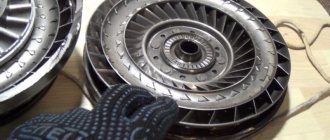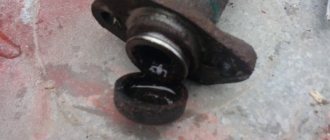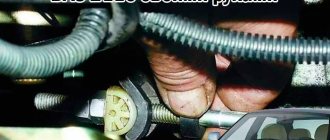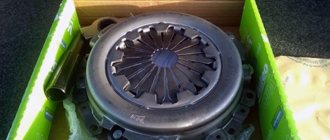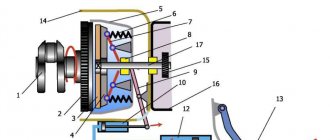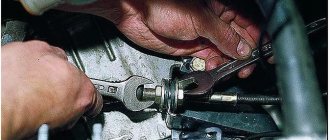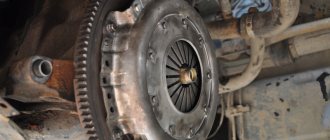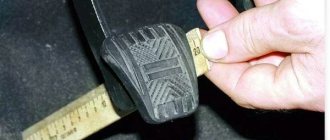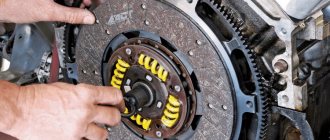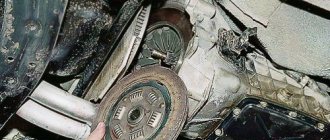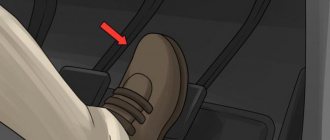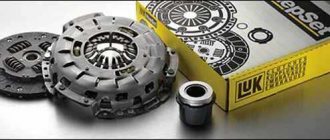Operating the clutch pedal will require confidence and restraint on your part. The clutch pedal plays a leading role when driving a car with a manual transmission, it is designed to briefly disconnect and engage the engine and transmission. The transmission is the clutch itself, the gearbox and the wheel drives.
Cars with an automatic transmission do not have a clutch pedal.
Correct starting and further movement will depend on how we operate the clutch and gas pedal, and the brake, of course.
Although this is a classic, I just want to add some element of my own to the learning process.
To quickly master the use of your legs to operate the pedals during starting and further movement, now, sitting right at the computer, you can do a simple and even entertaining exercise to make it easier to control your legs.
It's very simple, the exercise is to ensure that the legs do not repeat each other's actions.
To do this, let’s sit down and try to work with our legs in different directions.
So, for example, we will smoothly stroke the floor back and forth with our left foot, and spank the floor with our right foot.
Or, use your left foot to slowly release the clutch pedal, and use your right foot to frequently press and release the gas pedal, but you need to do this with both feet at the same time. You can do this on a car with pedals, but this is the second stage. You can also stroke yourself on the head with one hand and at the same time pat your tummy with the other hand, but this is already the “third stage”, so you will praise yourself or punish yourself...
This is called controlling your nerve endings.
So, about 99% will not succeed the first time.
This is approximately how our feet will work with the clutch pedal when starting off and in general when further driving the car.
Over time, this will happen automatically; for some, automatism will manifest itself faster for others, and for others it will take longer, because muscle memory works differently for everyone. Don’t be afraid to press the pedals and make it easier for yourself, as it’s more convenient for you, and then things will come to automaticity faster.
If you spend more time on training, this will happen quickly and even unnoticed by yourself. Just when training, you don’t need to put all your attention on your feet, but try to connect the behavior of the car with your conscious actions with your feet and hands, because it is you who are driving the car, not the car. To begin with, just tell yourself: (turn on or change gear) - “ press the clutch pedal” ; (stop) - “press and hold down the clutch pedal until the pre-shift is turned off”
The most important point in working with control levers on a car with a manual transmission is to learn how to smoothly transfer engine speed to the wheels; for this you need to properly learn how to operate the clutch pedal.
Each one is a different car and behaves differently when starting, so no matter how many cars you change, each time you will have to get used to the habits of the new car. Simply, the operation of the mechanisms and the travel of the clutch pedal cannot be adjusted in exactly the same way. The reason for this may be wear of the clutch discs and cable stretching, various gaps in the mechanism, etc.
To move smoothly, you need to work hard. This moment requires careful training. This is for almost the rest of my life. The main thing is to understand and feel this work, for this:
- we will practice using our left foot to press and smoothly release the pedal,
- after pressing the clutch pedal , turn on the gear,
- We slowly begin to release the pedal and catch the moment when the connection occurs - the clutch of the engine speed with the wheels.
How to use the clutch correctly
Having purchased or are planning to purchase a personal car, we diligently learn the rules of the road in order to obtain a driver’s license and become, as we think, a full-fledged driver.
At the same time, not everyone and does not always remember the rules for operating a car, in particular, its main component – the chassis. Meanwhile, this area is fraught with many mysteries and secrets. For example, how not to burn out the clutch when moving away and performing this or that maneuver on the road.
First of all, let’s understand at least superficially what it is and what functions this unit performs on the car.
Emergency braking without ABS
There are cars that do not have ABS or it has failed, what should you do in such cases to achieve complete wheel locking? And in this case, it is necessary to accurately calculate the force on the brake. But here it is worth understanding that braking will also differ with different road surfaces.
If the car has a mechanic, and at the same time depress the clutch pedal, then you can stop the car with the slightest pressure on the brake. In such situations, it is necessary to correctly determine the force on the brake pedal. And if we talk about emergency braking, then every driver thinks about how to avoid a collision, and not about the depressed pedals.
In general, braking can be sport braking, which was planned and not related to an accident and is an emergency braking to avoid a collision.
What is clutch
The clutch serves to disconnect the crankshaft and gearbox for a short time, as well as for their subsequent connection. This operation is necessary when starting a car and to change speed while driving.
The most common on cars and most trucks is a single-plate friction type clutch.
It consists directly of the clutch mechanism and the release drive.
Critical wear of the disc is easy to determine when driving in fourth gear: if, when you press the gas pedal intensely, the engine roars, but the car does not run faster, the disc needs to be changed. This may be accompanied by a burning smell.
The greatest and most common threat to the linings on the clutch disc from inexperienced motorists occurs when the car starts moving. Therefore, we will consider this process in detail.
We brake to a complete stop: to the clutch - “yes” or “no”?
The simplest situation is braking until the car comes to a complete stop on a straight section of the highway. After pressing the brake pedal, wait until the car comes to an almost complete stop. And only when the engine speed drops to the idle level, you need to release the clutch. This is done to prevent the engine from stalling. With this type of braking, it is possible to avoid complete blocking of the wheels, when a car moving at speed can turn into an uncontrollable rocket.
Another advantage of braking with a working clutch on a straight line is that you can stop braking at any time and resume the movement of the car. From a technical point of view, the greater efficiency of the braking system when the engine is running is explained in this way: all modern cars are equipped with vacuum boosters that work better when the drive is not disconnected.
When driving with the clutch depressed or in neutral gear, there is a high probability of the car's wheels getting stuck, which causes the brakes to overheat, causing uncontrolled skidding and other dangerous consequences. This is especially true when the car is moving downhill or on an icy road. If anyone remembers from childhood how a sled slides down a hill: there is no way to change the speed of movement or its trajectory.
Modern cars with anti-lock braking systems are no exception to this rule. The moment the ABS releases the brakes, when the clutch is disengaged, the wheels stop braking completely, which ultimately increases the overall braking distance. When driving in gear, even at the moment the ABS is activated, the braking does not stop - it continues to be carried out by the engine.
From this we can conclude: even in the simplest driving situation, even in the most modern car, you should always brake with the gear engaged.
How to get moving correctly
So, your engine is started and running in neutral. You depress the clutch pedal and engage first gear. Now you need to smoothly connect the crankshaft to the gearbox. This means that you need to press the driven disk against the flywheel rotating at a speed of 20-25 revolutions per second. To prevent the car from “jumping” and the engine suddenly stalling, we will perform this operation in three stages.
- Stage 1. Release the clutch pedal slightly. The pressure plate springs will bring the driven disk into light contact with the flywheel - your car will move and slowly begin to crawl.
- Stage 2. Hold the pedal in this position for two to three seconds. The rotation speeds of the flywheel and disk are gradually equalized - your car accelerates.
- Stage 3. The car drives confidently on the road - the torque is 100% transmitted to the gearbox. Release the pedal and remove your foot from it. A further half-engaged state of the clutch will burn the discs .
At the traffic light
According to numerous testimonies of novice drivers, some driving instructors teach to wait for a green traffic light with the clutch depressed and first gear engaged. It would seem that the discs do not touch, there is no threat of the linings burning. But in this case, the release bearing wears out. In the end, this negatively affects the engine in general. Therefore, put it in neutral and release the clutch pedal.
In a traffic jam
Perhaps the greatest threat to traction comes from driving in traffic jams. Some drivers do not take their foot off the clutch pedal for a long time, turning it on and off, leaving the engine in first gear.
The driven disk almost constantly rubs against the flywheel disk, and asynchronously. As a result, additional heating occurs, which contributes to more intense abrasion.
Try to move in traffic jams, covering short distances in stages, turning off the gear in between and releasing the clutch.
On the descent
On steep descents, you cannot turn off the gear. It is recommended to descend at first speed with braking using the foot brake, and be prepared, as a last resort, to use the hand brake. There is no need to use the clutch pedal. Moreover, it may pose a risk of engine stalling.
Main types of braking
Standard braking
This type of braking occurs in the event of a planned stop of the vehicle. This could be stopping at a traffic light in order to park or let a car or pedestrian pass.
This approach allows you to maintain the desired trajectory, and, if necessary, quickly gain speed.
Engine braking
This type of braking is acceptable, most often on long descents. In such a situation, the driver takes his foot off the gas pedal, thereby stopping the flow of fuel and reducing engine thrust. Smooth braking occurs, without stress on the braking system.
Stepped combined braking
The essence of such braking is to periodically press the brake pedal over a short period of time. The force of pressing the pedal depends on the situation:
- on snowy, icy road surfaces or off-road, a stepped braking method is used with increasing force;
- on dry asphalt or concrete, a stepwise method with decreasing force is used.
Emergency braking and steering
It is best to use the pulse (step) method of braking during emergency braking. If necessary and if the situation allows, you can gradually switch to lower gears.
Taxiing is performed during periods when the brake pedal is released. The steering movements are so short, impulsive, without intercepting the hands. With this approach, the trajectory will be more predictable and there will be less risk that the car will go into an uncontrolled skid.
It is PROHIBITED to lean forward and hold tightly to the steering wheel in an emergency situation . It is best to rest your back against the back of the car seat. With this arrangement, you will better feel the behavior of the car and the beginning of a skid.
Riding in extreme conditions
Driving with slippage truly “kills” the clutch, which often happens in unforeseen, extraordinary conditions. When we happen to get out of a puddle or a snowdrift, we are forced to speed up the engine, giving it high speeds and sharply engage the clutch.
In this situation, not only the linings on the disk burn fatally. Such harsh operating conditions also threaten more serious damage, including to other vehicle components. Therefore, if possible, ask to be taken in tow. Don't burn the clutch.
Why does it burn
It is at the moment of incomplete contact with each other of the disks rotating at different speeds that the linings burn out. Whenever we operate the clutch incorrectly, the gap gradually increases, and subsequently the squeeze becomes incomplete - the clutch begins to slip. The disk needs to be changed.
It's OK. After all, this is an ordinary consumable part for your car, designed for approximately 80,000 km if used correctly.
Source
How to use the clutch correctly - how it works, how to depress the clutch and release the pedal
How to drive a car correctly and how to press the control pedals correctly is taught in driving schools, but it happens that even many years of driving experience do not teach you to take care of the clutch in the car - it simply wears out quickly and requires replacement (and without a clutch, until it is replace the car, it won’t be able to drive)
In order to understand how to properly use a car clutch, you need to have a good idea of how it works and the purpose of individual components, for example, the pressure plate, which motorists have long dubbed the “basket.”
What is a car clutch
Structurally, the clutch (friction clutch) in a car is designed to connect and disconnect the engine shaft with an automatic or manual transmission.
This allows you to move away without sudden jerks and ensures smooth gear shifting on the move, preventing overload of the transmission components due to changes in the crankshaft speed.
There are different drive designs for transmitting force from the pedal to the pressing mechanisms, such as mechanical, hydraulic and electric.
Where is the clutch located in a car?
The purpose of the clutch is to transmit torque from the engine crankshaft to the gearbox, so structurally it is located between these two units.
The specific location may depend on the layout of the base units, front-wheel drive or rear-wheel drive transmission, but in any case it will be at the front of the car under the hood.
Car clutch device
Being a connecting unit for transmitting rotation, the design of a friction clutch in a car is not particularly complicated.
The main components are: Pressure disk - has release springs at the base and is designed to connect to the flywheel. Due to its petal design, it received the title “basket” for its similarity in appearance. The driven disk has a coupling, a radial base and linings.
Special damper springs help reduce shaking when switching. Release bearing - located on the input shaft and drives the drive fork. Some designs may use locking springs for a more secure fit.
Clutch pedal - with the help of it, the driver from the cabin controls the work process, transmitting instructions to connect or disconnect the engine drive shaft and gearbox. In cars with an automatic transmission (automatic transmission) there is no pedal; the system operates using a special servo drive.
Automatic car
In the automatic version, the clutch occurs according to the “wet” type using transmission oil enclosed in a torque converter and two impellers. The flywheel blades carry with them a flow of oil, which spins the pump wheel - this is how rotation is transmitted in an automatic transmission (automatic transmission)
Such an automatic car does not have a clutch pedal, so in general the driving process itself will be simpler and easier (there are especially many fans of automatic transmission among women).
Car with manual transmission
Photo: clutch pedal - left side
In a car, the clutch pedal is located in the leftmost position of the three pedals - the pedal in the center is the brake, the pedal on the right side is the gas, the left pedal is the clutch - and with its help the driver controls the connection of the engine to the gearbox.
Manual operation requires more attention compared to automatic, but for many users this is a matter of habit and a matter of price.
A car with an automatic transmission will be much more expensive to purchase and maintain, which is why many drivers choose cars with manual controls that have a clutch pedal.
Correct use of the clutch pedal
It will be useful for a beginner to learn how experienced motorists use a car clutch correctly and how the clutch works.
By applying simple recommendations in everyday driving, a beginner will achieve mastery much faster if he learns to change gears correctly and engage the desired speed, reducing the load on the tires and brake discs.
This applies to such driving moments as short stops, for example, at traffic lights and on turns.
How to properly depress the clutch
In essence, the correct use of a friction clutch involves the precise execution of two interrelated operations - the pedal must be pressed and then released.
Simple tips will tell you how to properly squeeze the clutch:
The pedal is pressed all the way and without delay. Since the main thing is experience, it is better not to waste time on training, finding a suitable platform for this and hiring an experienced driver for the company.
At the very beginning of training, shoes are important - to make the sensations more pronounced, they should have thin soles and no heels.
How to release the clutch correctly
By releasing pressure on the pedal, the driver begins to connect the engine flywheel and the driven disk to transmit rotation to the gearbox.
This must be done very carefully and smoothly - there are several recommendations for novice car enthusiasts on how to release the clutch so that the ride is as comfortable as possible:
The pedal should not be depressed for a long time; the pedal should be gradually released without sudden thrusts, pausing slightly when it is pressed halfway.
The car must start moving from first gear. You can start from second gear only in winter, when the road or some sections of the road are very slippery (if you start on slippery ground in first gear, the wheels will slip and it will be difficult to move at all).
Video: How to properly use the clutch in a car
Video: How to properly release the clutch and operate the pedals in a car
Source
General structure of the car
The clutch is turned on and off by the driver using the pedal (when the pedal is pressed, the clutch is disengaged).
When you press the pedal, the clutch discs move apart, the drive disc connected to the engine rotates, but this rotation is not transmitted to the driven disc (the clutch is disengaged). The clutch must be disengaged during the period of engaging or shifting gears to ensure a shock-free connection of the gears in the gearbox. When the pedal is smoothly released, the drive and driven disks engage smoothly. At the same time, due to slipping, the driving disk smoothly imposes rotation on the driven disk. It begins to rotate, transmitting torque to the input shaft of the gearbox. Thus, the car will start moving when starting off or continue moving in a new gear.
Clutch, clutch operating principle
The gearbox is used to change the torque (speed), direction of movement and long-term disconnection of the engine from the transmission while the car is parked and when it moves by inertia. The gearbox is controlled by the driver using the shift lever.
When the engine is running, to engage or change gear, you need to depress the clutch pedal (disengage the clutch).
The cardan transmission allows you to transfer torque from the gearbox to the rear axle (main gear) in conditions where it changes its position when the vehicle moves over uneven roads.
The main gear serves to increase torque and transmit it at right angles to the vehicle's axle shaft.
The differential ensures that the drive wheels rotate at different speeds when the car turns and the wheels move on uneven roads.
Axle shafts transmit torque to the drive wheels.
The chassis ensures movement and smoothness. It includes a subframe, usually combined with the car body, to which elements of the front and rear axles with hubs and wheels are attached via front and rear suspensions.
Steering is used to change the direction of movement of the car using the steering wheel.
Braking system - reduces the speed of the car, holds it on descents and ascents. The brake system is controlled by the driver using the main brake pedal and the handbrake lever.
The main braking system is usually multi-circuit, i.e. When you press the brake pedal, the front and rear wheels are braked by independent brake actuators. And if one circuit fails, the other will continue to perform the braking function, although less effectively.
Multi-circuit improves traffic safety.
The electrical equipment of a car includes sources of electric current (battery, generator) and electrical consumers (starting and ignition systems, lighting, alarm devices, instrumentation, windshield wipers, windshield washer systems, heating and ventilation systems, etc.).
The battery energy is used when the engine is not running, the generator energy is generated only when the engine is running, it is used to recharge the battery and power other vehicle consumers.
The main controls of the car are: steering wheel, gas, brake and clutch pedals, handbrake lever, gear shift lever.
Auxiliary controls include turn signal switches, windshield wiper switches, windshield washer switches, headlight switches, foot light switch, carburetor choke control button, ignition switch, starter switch, ventilation and heating system controls, hood lock lever and others.
The main instrumentation is located on the driver's instrument panel.
Control and measuring instruments include:
signal lamp for turning on external lighting,
warning lamp for turning on fog lights,
signal lamp for turning on the high beam headlights,
speedometer and trip meter,
engine temperature gauge,
Determining the dependence of heat input into the car from the amount of cargo in the car To determine the dependence of heat input into the car from the amount of cargo in the car, we need to calculate heat inflows depending on the amount of cargo: Q3 and Q4. For different quantities of cargo.
Analysis of the Russian market for passenger route intracity transportation The share of transport costs in the total consumer expenses of the working part of the population ranges from 5 to 7%. Dissatisfaction with the increase in transport tariffs was expressed by 77% of those surveyed by the Levada Center. Those. Not .
Analysis of existing stand designs According to the above requirements for the stand design, we are suitable for: a stand for cold straightening of the front axle, model 9001, as well as a stand for cold straightening of the front axle, model 115, designed for .
Source
Tip 1: How to learn to drive a manual transmission
Learning to drive a manual transmission seems impossible for many novice drivers. However, the ability to cope with the “mechanics” is the basis of the fundamentals of driving skills. Let's look at the most popular misconceptions and mistakes that prevent you from learning how to drive a car competently.
Instructions
- It's difficult to get started with a manual transmission. It's difficult to get started only because you don't feel the car well yet. The beginning of a movement is a combination of several actions that must be performed sequentially. The legs cannot yet work synchronously to push/pull the pedals. Hence the constant jerking at the start. Don't ignore the tachometer readings. Correctly dialed speed will allow you to start and drive smoothly.
- I don’t know how to change gears While driving, you need to change gears to increase speed. Many people do not know at what point it is necessary to switch to increased or decreased speed. Each gear corresponds to a speed segment. The first speed is needed to start moving or to move very slowly, for example, in a traffic jam. After starting to move, you need to accelerate a little and immediately switch to second. Then watch the instrument panel. When the needle starts to approach 30-40 km/h, switch to third. After 50 km/h, engage fourth gear. Engaging fifth gear on different cars can vary from 80 to 100 km/h.
- It’s easier to drive with an automatic transmission. It’s really easier to drive a car with an automatic transmission. The period of learning and adaptation on the road is noticeably reduced. It’s safer to drive in traffic jams with an automatic, because your legs rest. But winter driving in such a car can be greatly complicated by weather conditions. It is easier to get a car with a manual transmission out of an uncontrolled skid or drift. Because you can operate the clutch and brake with the engine. And if you get stuck in a snowdrift, it is much more difficult to rock a car with an automatic transmission.
- Manual transmission provides more opportunities for confident driving. Fans of manual transmission consider its most important advantage to be the maximum opportunity to drive the car independently. You can choose the required speed for acceleration yourself, without waiting for the system to switch itself. Manual transmission provides more opportunities for fast, dynamic driving. It’s not just that all racing cars are equipped with “mechanics”. And most importantly, if you understand the manual transmission, you will no longer be afraid of any problems. Life is different, and sometimes you have to, contrary to your wishes or in the current situation, get behind the wheel with a manual transmission. And if a person has never done this, then he will have a very, very difficult time on the road.
Reversing turn
There may be a need to turn around on a site, but the availability of free space does not always allow you to do this in one go. For example, in a small area, in a cramped alley or in a narrow garage driveway.
In such situations, the most appropriate maneuver would be a three-step turn, one of the elements of which is reversing. Turning in this way is one of the examination exercises in the traffic police.
Imagine that your car is parked on the right side of the road and you need to turn around. The width of the road must be greater than the length of your car, otherwise you will not be able to make a U-turn.
It must be remembered that it is quite difficult to turn the steering wheel when the car is stationary (if there is no power steering), so it makes sense to start turning it during the start, when the wheels have already rolled.
You can use the following action plan.
- Engage first gear, start driving, and immediately quickly turn the steering wheel to the left all the way. Move in an arc to the left side of the road.
- When the car begins to approach the left edge of the road, depress the clutch and immediately, while the wheels are still rolling a little, turn the steering wheel to the right as far as it will go or as far as possible. When you reach the edge of the road, you stop. Now you are ready to move backwards.
- Engage reverse gear and start moving backwards, at the same time turning the steering wheel to the right if you were unable to do this just before stopping.
- As soon as the car moves back a sufficient distance, depress the clutch and, again, while the wheels are rolling, quickly turn the steering wheel and turn the front wheels to the left. You stop the car.
- Now turn on first gear and start moving forward, but in the opposite direction. The reversal is over.
If three techniques are not enough, then you will need to repeat the “back and forth” manipulations the required number of times. In more detail, turning in reverse and possible options is described in the article Performing a turn. Part 1.
Tip 2: How to learn to drive manually
Learning to drive a car with a manual transmission is more difficult than learning to drive a car with an automatic transmission. But, if you practice long enough, this science is given to everyone. You can master mechanics either with the help of a qualified instructor or on your own.
Instructions
- Sit comfortably in the seat and adjust it to suit you. Adjust the rear view mirrors. If possible, lower the windows to better hear the sound of the engine. Look at the pedals. In all cars, the left pedal is the clutch, the middle pedal is the brake, and the right pedal is the gas. Fully depress the clutch. Adjusting your seat should allow you to do this without difficulty.
- The manual transmission lever is located in the center of the cabin between the front seats. On the knob there is a diagram of the gears. Remember it. Make sure the gearbox lever is in neutral. To do this, pull the lever left and right. If it walks freely, it means the speed is in neutral.
- Depress the clutch and start the engine. Remember this and get into the habit of starting the engine with the clutch depressed. Then engage first gear according to the diagram. Most often, to do this, you need to move the lever to the left and up. Then begin to smoothly and slowly release the clutch until the engine runs noticeably quieter.
- As soon as the engine speed drops, remember this moment for yourself. It is very important in order to learn how to get started on the mechanics. In order for the car to move at this very moment, you should begin to smoothly press the gas while continuing to release the clutch. If you release the clutch too quickly or too slowly, the car may stall.
- After you learn how to start, learn to change gears while moving. At approximately 3000-4000 engine rpm, release the gas pedal and simultaneously press the clutch. While the car is coasting, engage second gear and smoothly release the clutch. Then apply gas. Do not keep your foot on the clutch pedal all the time. Place it on the special platform to the left of the pedal.
- If you need to stop, take your foot off the gas pedal and press the brake. As soon as the speed drops to 10-20 km/h, depress the clutch and shift to neutral. Subsequently, train yourself to brake with the clutch depressed or in neutral.
Note!
When starting off and while driving, never look at the pedals. Always look forward.
Helpful advice
If you have an assistant, let him support you in the first stages of training. In case of any danger, he must quickly brake the car with the handbrake, and before that he must constantly be on alert.
Starting a car on a hill
Many novice drivers experience serious difficulties when starting a car on an incline. But, knowing the principle of operation of the manual transmission clutch and the sequence of actions, they will do it much more confidently. This sequence of actions can be used when the handbrake in the car does not work well:
- the clutch and brake pedals are initially depressed with the engine idling;
- the clutch pedal is slowly and smoothly released until the engagement of the clutch disc and transmission is felt, at which point the car begins to tremble;
- the foot is removed from the brake pedal, but the car will not roll backwards, since the clutch acts as a brake;
- the gas pedal is pressed and the car begins to roll forward.
Why does a partially released clutch replace the brake pedal? This effect is the result of the captured force balance between the force of gravitational attraction and the static friction force of the wheels. Their immobility is ensured by the balance of the engine force that pushes the cars forward and the same static friction force. But such work with the clutch when stopping increases wear on the friction material of the clutch disc.
Tip 3: How to learn to drive a car
Studying at a driving school is the basics, and perfection comes with kilometers behind the wheel. At a driving school you will only be given a theoretical and practical knowledge base, which will be very difficult for you during your first days on the road. Improving your skills should be done with an experienced person who can point out mistakes and teach you how to perform elements and technical nuances.
- Get on the road every day. Until you have muscle memory, you need to rack up as many driving hours as possible. It could even be circling around a deserted parking lot or leisurely driving along a country road. Your goal is to get used to the car, to bring acceleration and braking to automaticity, a straight trajectory, and to get used to the dimensions of the car.
- Get rid of psychological pressures and fears. Your uncertainty gives rise to mistakes and dissatisfaction of other participants in the movement. Place a “Student Driving” sign (exclamation mark in a yellow square) on your rear window. For other drivers, this will be a sign that there is no need to make sudden maneuvers and lane changes in front of you, or to honk in response to your slowness. If at any point you feel like you are losing control of the situation, turn on your hazard lights and pull to the side of the road. Take a break, think and hit the road with renewed vigor.
- Learn to predict the actions of traffic participants. You should always be in control of everything that happens around your vehicle. You must calculate the cars ahead two ahead. If a truck is driving in front of you and is blocking your view, overtake it or change lanes. Otherwise, a situation is possible when the car in front suddenly changes lanes in front of an obstacle that has arisen, and you will not have time to do this.
- Students say that the most difficult thing is working with a manual transmission and changing lanes in heavy traffic. Mastering the “mechanics” takes more time, but you will also get more pleasure from driving. Plus, manual transmission is more convenient and safer in winter. Changing lanes in heavy traffic requires the driver to have a sense of speed and distance. You need to learn how to accelerate to the speed of the flow, maintain it and change lanes at a safe distance.
Tip 4: How to learn to drive a car
Getting started is the most difficult part of learning to drive a car. But it’s rarely possible to achieve a smooth ride the first time. If you understand the principle and learn to feel the operation of the engine, then it turns out there is nothing complicated about it. Instructions
- Getting moving in a car with a manual transmission is the very first element that students begin to perform in a driving school. And really, there is no other way. But this is where the first problems begin - the car jerks, hums and stalls. But if you do everything correctly and consistently, you yourself will stop noticing how you got on.
- On a car with a manual transmission, to start driving, you need to depress the clutch, engage first gear, and, while depressing the clutch pedal, press the gas pedal. It doesn't seem complicated. Now let’s look at all the errors in detail.
- When you start pressing the gas pedal, the clutch pedal must be released smoothly. What happens is that the clutch pedal continues to be held, accelerating and increasing the speed, or it is abruptly released without starting to move and the engine stalls.
- Monitor the tachometer operation. You can start by accelerating a little, keeping an eye on the needle. You need to understand at what tachometer value there is enough revolutions for the car to move.
- The clutch and gas pedals must be depressed simultaneously, with the same force. If you suddenly feel that the clutch has been depressed too much, press the pedal again. Your main task is to move off smoothly and not stall. You don't need to gas it a lot. If you give a lot of gas, then the clutch pedal should be released very quickly. And you will start slipping.
- You need to not miss the moment when the required speed is reached, the car will begin to make a jerk. Lower the clutch almost all the way. But hold it a little until the car moves a couple of meters. And only then can you release the clutch completely.
- A simple exercise will help you understand where you can release the clutch pedal. Turn on first speed. Do not press the gas pedal. Begin to slowly release the clutch pedal. At a certain moment, the car will move smoothly and slowly. And you need to remember at what point in the clutch pedal position the car starts moving.
Tip 5: How to learn to drive a manual car
The majority of Russian car enthusiasts are owners of cars with a manual gearbox (MT). Most driving schools teach driving on just such vehicles. Therefore, the problem arises of how to learn to drive a car with a manual transmission.
- The first step is to understand the box system. A manual transmission usually has 5 steps, which are numbered. Gear changes occur while pressing the clutch pedal. Therefore, first you need to learn how to change gears correctly and on time. Without starting the car, you need to get behind the wheel and for one hour methodically change gears according to the following scheme: “clutch - gear - clutch - next gear” and so on until the last step. We must not forget that while changing gears you must keep the clutch pedal depressed, otherwise you will not be able to shift.
- The next step is to learn to understand when to change gear while driving. The signal for switching is engine speed. Either by sound or by the tachometer it is necessary to monitor the engine speed. Experienced drivers determine the moment of switching from a lower to a higher gear only by sound. The smaller the engine displacement, the faster the switching point occurs. If the speed needs to be reduced, then at the right moment, when the speed is below the tachometer readings, you need to switch the box to a lower gear. Otherwise, the gearbox will experience increased wear.
- Once a novice driver understands the basics of shifting gears, he needs to make the gear shifting process automatic. The best time for this is on weekends, when the roads are clearer and while driving it is possible to both slow down and accelerate using a manual gearbox. Traffic jams can also be useful for this, when the driver needs to quickly change the lowest gears.
Helpful advice
All manual transmissions have a neutral position. Unlike other gears, driving on it is impossible. But if you put it in neutral and release the clutch pedal, the engine will not stall. This is very useful when driving in urban conditions, when you have to stand at traffic lights and in traffic jams, relieving stress from your legs.
Source
